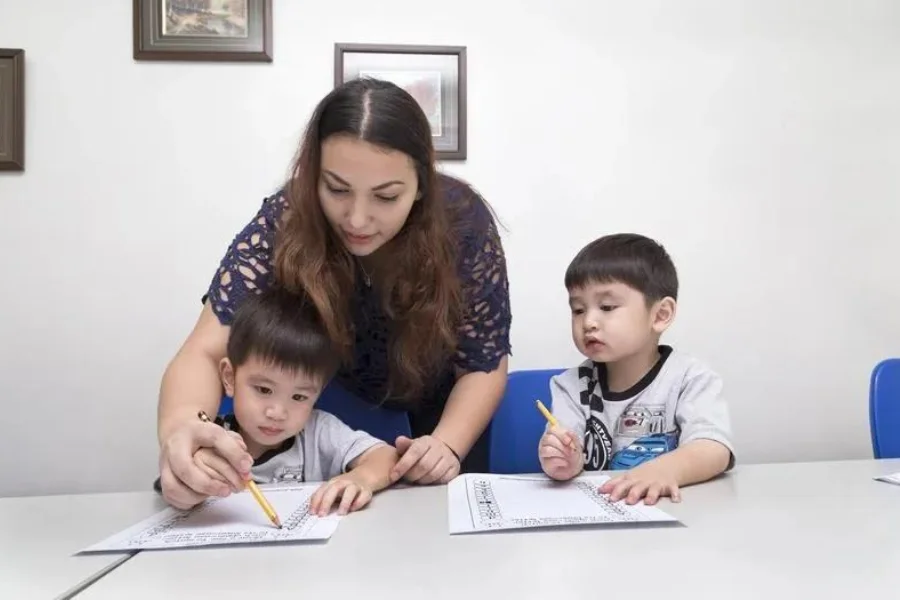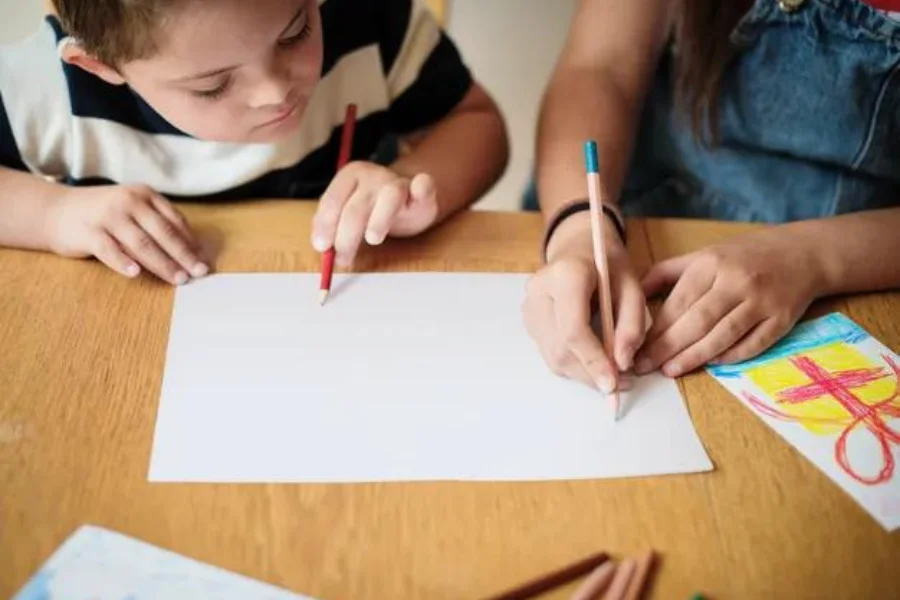
Source: alamy
A Shadow Teacher Meaning is the cornerstone of a child’s academic journey. When a child faces struggles due to any disabilities, a shadow teacher ensures that the child duly receives the educational support that he is entitled to and comfortably accommodates himself into mainstream education.
A Shadow Teacher is like a shadow that never leaves the child’s side and continues supporting him in the classroom. The ultimate goal of the Shadow Teacher is to guide and mentor the child until he is confident in his ability to function independently. Shadow teachers’ meaning lies in their dedicated efforts to assist one specific student, tailoring their guidance to meet the child’s educational and behavioral requirements.
Shadow Teachers are thorough professionals who liaise effectively between the class teachers, parents, therapists, and caregivers to work together focusing on the child’s strengths and fostering their holistic growth that includes helping them manage their behavior patterns and navigate through their emotional melt-downs.
This blog highlights the intricacies of Shadow Teachers Meaning their job role and their significance in creating a conducive learning environment celebrating the diversity of children.
For more details on the STT Course Call/Whatsapp at +919321024137 / +919869866277
To download the brochure of the STT Course, Click Here!

Source: freepik
Which Course Provides Shadow Teacher Meaning?
If you’re considering a career as a shadow teacher or want to understand the shadow teachers meaning better, enrolling in a dedicated training course is an essential step. These programs focus on teaching strategies that enhance the learning experiences of children requiring individual attention. One such reputed institution offering a Shadow Teacher Training Course is Vidhyanidhi Education Society (Govt. Regd.), known for its comprehensive approach to preparing skilled professionals in the field of special education support.
Below are the key areas typically included in such a program:
Understanding Learning Needs
Gain insights into the challenges faced by students with learning differences such as autism spectrum disorders, ADHD, or specific learning disabilities. Learn to identify their individual needs and create strategies to address them effectively.
Inclusive Education Strategies
Develop techniques to foster an inclusive learning environment. This includes adapting lesson plans, simplifying instructions, and ensuring that the student can engage meaningfully in classroom activities alongside peers.
Behavioral Support and Management
Learn methods to help students regulate their emotions, manage social interactions, and improve focus. This component focuses on creating a supportive atmosphere that encourages positive behavioral changes.
Productive Partnerships
Learning the crucial skills of being an excellent lucid communicator can help to form a productive collaboration between classroom teachers, parents, and therapists. Clear communication helps all the parties in the child’s overall progress to be aware of the student’s development.
Practical Training and Real-Life Application
One of the most effective teaching techniques is learning while doing which includes engaging activities such as role-play, skit, and dramatic representations that help children to understand the concepts clearly and apply them in a real situation.
Vidhyanidhi Education Society (Govt. Regd.) stands out as a trusted name in shadow teacher training. Their course is structured to provide a balanced mix of theoretical knowledge and practical application, ensuring that aspiring shadow teachers are well-prepared for the challenges of the role.
What are Shadow Teaching Methods?
Shadow Teaching methods are tailor-made approaches designed keeping in mind the strengths and weaknesses of the student that help to attain their learning goals and bridge any gaps that have arisen. These methods are devised by thoughtful planning that are full-proof tested approaches that comprise of different teaching tactics, various pedagogies that help the child not just excel in academics but develop a confident personality and be able to form meaningful friendships.
Shadow Teaching Methods provide the desired personalised guidance that enables children to function independently in mainstream classrooms effectively.
Key Shadow Teaching Methods:
Building Trust
Establishing trust is the foundation of shadow teaching. Shadow teachers create a safe and supportive environment by building positive relationships with students, parents, and educators, encouraging students to engage confidently in learning.
Clear communication
Establishing clear lines of communication helps all the important people involved in the child’s development to know the progress of the child. Periodic feedback and updates encourage parents and teachers to work closely and cooperate to maximize the outcomes.
Patience and Empathy
Shadow teachers approach their role with patience and empathy, understanding the challenges students face and offering emotional support to help them feel valued and understood.
Adapting Lessons
Shadow Teachers must excel at expecting the unexpected as children with special needs have temperament problems that can disrupt the ongoing class without any learning outcomes.
Shadow Teachers should always have an alternate plan whereby they can modify the lesson to cater to the learning preferences of the child ensuring that the learning goals are attained.
Collaboration with Specialists
Shadow teachers often work with therapists or school psychologists to implement customized interventions that support the student’s development.
Promoting Independence
Gradually reducing direct assistance encourages students to make decisions, solve problems, and actively participate in class, fostering self-reliance.
Observation and Assessment
Monitoring the student’s progress and behavior helps shadow teachers identify areas for improvement and adjust their methods to meet evolving needs.
By applying these shadow teaching methods, shadow teachers empower students to overcome challenges, build confidence, and achieve greater independence in their learning journey.
For more details on the STT Course Call/Whatsapp at +919321024137 / +919869866277
To download the brochure of the STT Course, Click Here!

Source: henryford
What is a Shadow Teacher Job?
A Shadow Teacher Job involves offering consistent assistance to the single student for whom they are responsible to help them manage their classwork and participate fully in classroom activities instilling in them the confidence and boosting their morale to give their best to attain their true potential.
A Shadow Teacher Job has a major role to play in enabling the child to understand their emotional behavior patterns and devise strategies to regulate their emotions to develop great bonds with their peers.
Helping each child recognize their strengths to lead meaningful lives with success and self-respect is the prime goal of a Shadow Teacher.
Key Responsibilities of a Shadow Teacher Job:
Classroom Support
A shadow teacher works alongside the student in a regular classroom setting. They help the child engage in class activities, complete assignments, and focus on key concepts, ensuring they stay aligned with the curriculum.
Promoting Inclusion
Shadow Teachers are the ones who create the maximum awareness about the struggles of children with Special needs. By doing so they promote a feeling of empathy and mutual respect amongst students that helps to create a supportive and happy learning atmosphere strengthening the concept of Inclusion even deeper into the setup of the classroom and school at large.
Behavior Management
Shadow teachers assist students in developing strategies to manage their emotions and behaviors. This includes identifying triggers, providing guidance during challenging moments, and helping them learn appropriate responses.
Collaboration with Specialists
Shadow teachers work closely with parents, psychologists, occupational therapists, and classroom teachers. They align efforts to address sensory needs, learning goals, and behavioral objectives.
Monitoring Progress
Regular observation and assessment are integral to a shadow teacher’s job. They track the student’s developmental progress, classroom performance, and interactions with peers, providing valuable comments to parents and teachers.
Shadow Teaching began as a way to support children with mild learning challenges but has developed to help students with a variety of needs. A shadow teacher’s job requires patience, adaptability, and strong communication skills to build a positive impact on a student’s learning journey. Through their dedicated efforts, shadow teachers ensure that students can achieve their full potential in an inclusive educational setting.
“Shape futures with Shadow Teaching! Join Vidhyanidhi Education Society’s STT Course!”
For more details on the STT Course Call/Whatsapp at +919321024137 / +919869866277
To download the brochure of the STT Course, Click Here!
FAQs
Which is the Best Shadow Teacher Course?
The Shadow Teacher Training Course by Vidhyanidhi Education Society is highly regarded for its practical approach, expert guidance, and comprehensive curriculum.
What is Another Name for a Shadow Teacher?
A different name for a Shadow Teacher is Student Aide which signifies their one-to-one assistance to the child ensuring that any academic gaps that exist are covered.
Can a Mother be a Shadow Teacher?
Yes, a mother can act as a shadow teacher if she is trained to provide the necessary support and meet the child’s educational and emotional needs.



